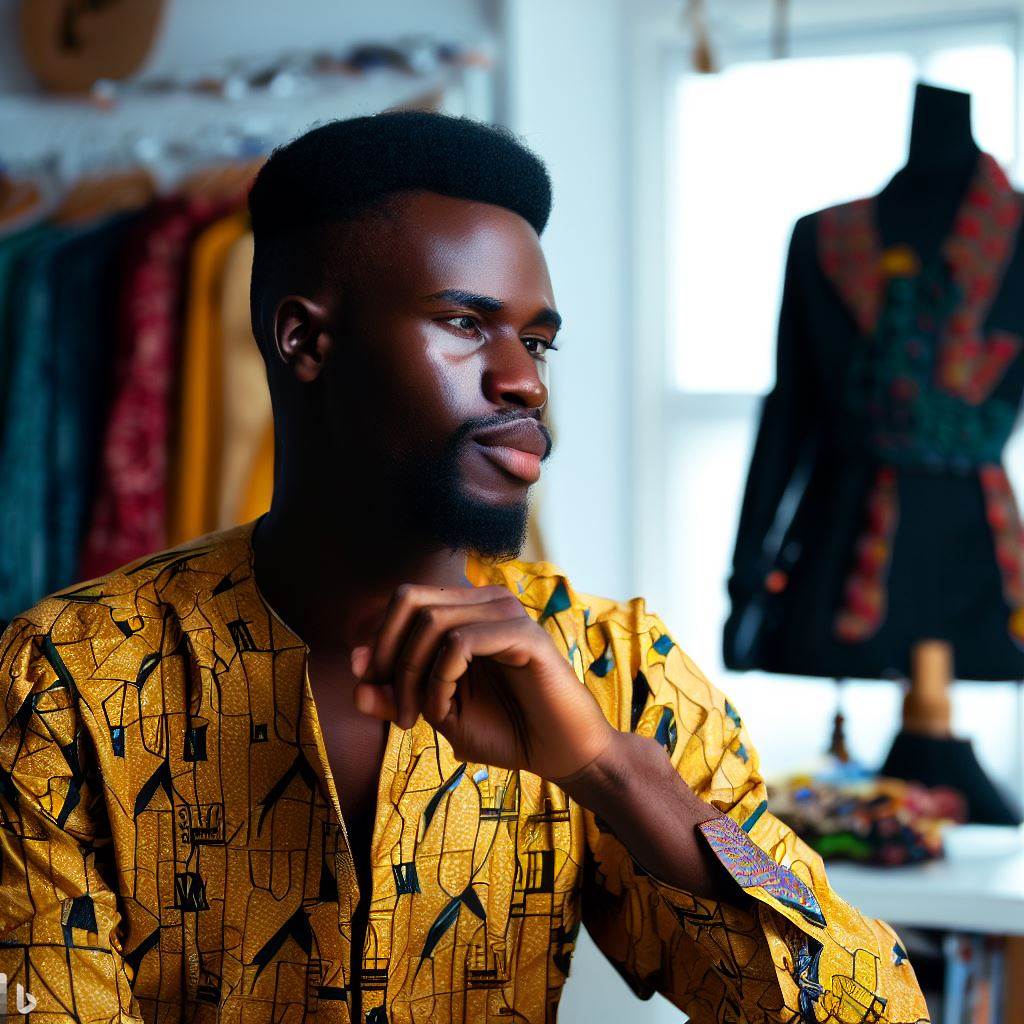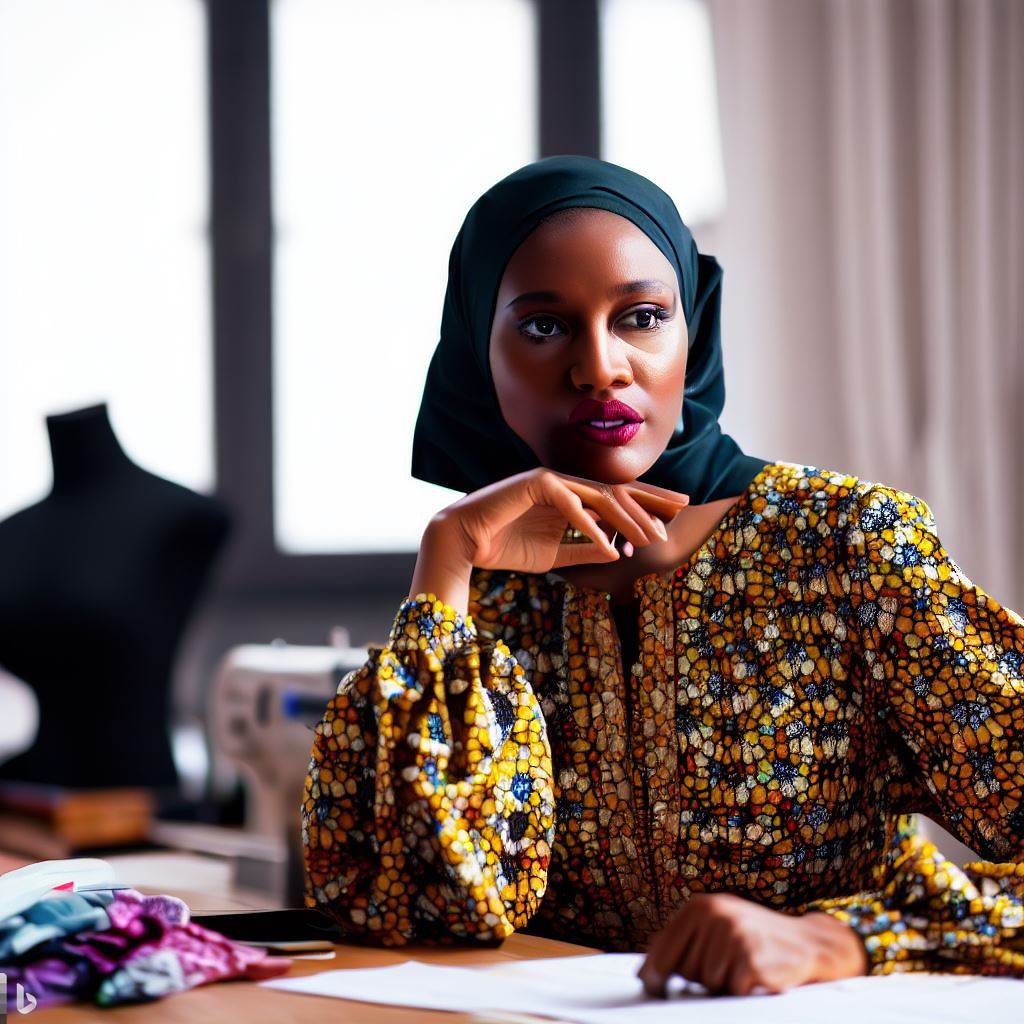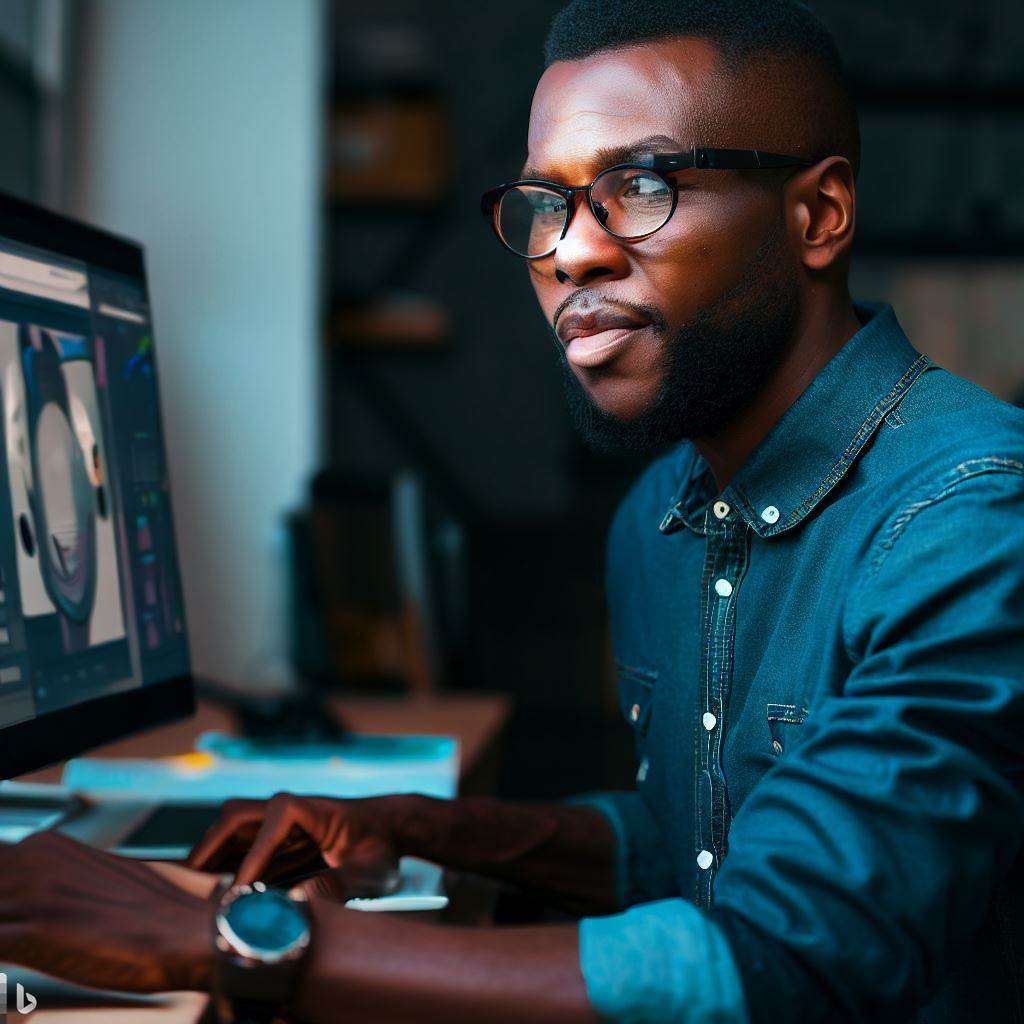Introduction
In Nigeria, the convergence of art and fashion design has led to a vibrant and dynamic cultural expression.
Nigerian artists and fashion designers have found inspiration in each other’s work, creating a synthesis that is both visually stunning and culturally significant.
Art has always been an integral part of Nigerian culture, with a rich history that dates back centuries.
The country is renowned for its traditional art forms such as pottery, sculpture, and textile design.
These artistic traditions have heavily influenced Nigerian fashion designers, who incorporate elements of this heritage into their creations.
The fusion of art and fashion design allows for the exploration of innovative techniques, materials, and styles.
Nigerian fashion designers often collaborate with local artists to incorporate traditional art forms into their designs.
This collaboration not only highlights the talent of Nigerian artists but also preserves and promotes Nigeria’s cultural heritage.
Furthermore, the intersection of art and fashion design in Nigeria provides a platform for social and political commentary.
Many Nigerian designers use their work to address important social issues such as gender equality, the environment, and cultural identity.
By combining art and fashion, these designers have the ability to communicate powerful messages through their collections.
Basically, the intersection of art and fashion design in Nigeria has resulted in a unique cultural expression that showcases the country’s rich artistic heritage.
This fusion allows for creativity, innovation, and the exploration of important social issues. It is a testament to the power of art and fashion to shape and define culture.
Historical Background of Art and Fashion Design in Nigeria
In order to understand the intersection of art and fashion design in Nigeria, it is important to first explore the historical background of both art forms in the country.
A. Overview of Nigeria’s traditional art forms
Nigeria has a rich artistic heritage, with traditional art forms dating back centuries.
These art forms include sculpture, pottery, textile weaving, and mask-making, among others.
Traditional Nigerian art is often characterized by its use of bold colors, intricate patterns, and symbolism.
Art was an essential part of Nigerian culture and played a significant role in rituals, ceremonies, and storytelling.
Traditional art forms were passed down from generation to generation, preserving Nigeria’s cultural identity.
B. Evolution of Nigerian fashion design
Nigerian fashion design has also undergone significant changes and evolution throughout history.
Historically, clothing in Nigeria was made primarily for practical purposes and to reflect cultural and social status.
Each region in Nigeria had its distinctive clothing styles, fabrics, and techniques.
Over time, Nigerian fashion designers began to experiment with blending traditional and modern elements.
The rise of urbanization and globalization has greatly influenced the evolution of Nigerian fashion design.
C. Influence of Western fashion on Nigeria’s fashion industry
The influence of Western fashion on Nigeria’s fashion industry cannot be underestimated.
With the arrival of European colonizers, Nigerian fashion started to incorporate Western styles and materials.
These influences continue to shape and inspire Nigerian fashion designers today.
The fusion of Western and Nigerian fashion elements has resulted in unique and innovative designs.
Nigerian fashion designers have gained international recognition for their creativity and ability to blend cultures.
Generally, the historical background of art and fashion design in Nigeria lays the foundation for understanding the intersection of these two art forms.
Traditional Nigerian art forms have played a vital role in preserving cultural identity, while Nigerian fashion design has evolved and adapted to changing times and influences.
The influence of Western fashion on Nigeria’s fashion industry has resulted in a fusion of styles that has gained global recognition.
The next section will delve deeper into the contemporary art and fashion scene in Nigeria and explore the ways in which these two creative industries intersect.
Read: Education for Fashion Designers in Nigeria: What You Need
Artistic Elements in Nigerian Fashion Design
A. Incorporation of traditional art motifs and patterns
- Nigerian fashion designers often incorporate traditional art motifs and patterns into their designs.
- These motifs and patterns are inspired by Nigerian cultural heritage and add a unique artistic touch to the fashion pieces.
- By integrating these elements, designers celebrate and promote Nigerian art and culture.
- Traditional art motifs and patterns can be seen in prints, embroideries, and embellishments on garments.
- These elements not only make the designs aesthetically pleasing but also carry cultural significance.
- The use of traditional art motifs and patterns sets Nigerian fashion design apart from others globally.
- Designers utilize these elements to create a fusion of contemporary and traditional styles.
- This incorporation of art into fashion design showcases the rich artistic heritage of Nigeria.
B. Use of indigenous textiles and materials
- Nigerian fashion designers also emphasize the use of indigenous textiles and materials.
- These materials are sourced locally and reflect the country’s diverse textile industry and craftsmanship.
- Fashion designers use fabrics such as adire, ankara, aso-oke, and gele in their designs.
- These textiles are known for their vibrant colors, intricate patterns, and unique textures.
- The use of indigenous textiles showcases Nigeria’s rich textile heritage and supports local artisans.
- Designers often incorporate these materials into both traditional and contemporary fashion pieces.
- By utilizing indigenous textiles, fashion designers contribute to the preservation of Nigerian textile traditions.
C. Collaboration between Nigerian artists and fashion designers
- Collaboration between Nigerian artists and fashion designers is a growing trend in the industry.
- Nigerian artists bring their creative vision and expertise to the fashion design process.
- Artists work closely with fashion designers to create unique textiles, prints, and embellishments.
- This collaboration results in one-of-a-kind pieces that blur the boundaries between art and fashion.
- The partnership between artists and fashion designers creates a platform for artistic expression.
- It allows artists to showcase their work beyond traditional art forms and reach a wider audience.
- These collaborations also foster creativity and innovation in both the art and fashion industries.
- The intersection of art and fashion in Nigeria promotes cross-pollination of ideas and inspirations.
Essentially, Nigerian fashion design incorporates various artistic elements, including traditional art motifs and patterns, the use of indigenous textiles and materials, and collaborations between Nigerian artists and fashion designers.
These elements help celebrate Nigerian art and culture, showcase the country’s rich heritage, and foster creativity and innovation within the industry.
By intertwining art and fashion, Nigerian designers create unique and culturally significant pieces that stand out globally.
Read: How to Start a Fashion Design Business in Nigeria
Fashion as an Artistic Medium in Nigeria
A. Exploration of fashion as a form of self-expression and creativity
- Fashion in Nigeria goes beyond just clothing; it is considered a form of self-expression.
- Nigerians use fashion to communicate their individuality, culture, and personal style.
- Through fashion, Nigerians can showcase their creativity and unique perspectives.
- Fashion designers in Nigeria experiment with different fabrics, textures, and patterns to express themselves.
- The vibrant colors and bold prints seen in Nigerian fashion reflect the country’s rich heritage and diversity.
- Fashion enthusiasts in Nigeria are constantly pushing boundaries and redefining traditional norms through their clothing choices.
- Nigerian fashion has the power to challenge societal expectations and make a powerful statement.
B. Fashion shows and exhibitions as platforms for artistic expression
- Fashion shows and exhibitions provide a stage for Nigerian designers to showcase their artistic visions.
- These events are not just about displaying clothing but also about telling a story and evoking emotions.
- Designers carefully curate their collections to create a cohesive narrative that resonates with the audience.
- Fashion shows in Nigeria are known for their theatricality, incorporating music, dance, and dramatic set designs.
- Attendees of these shows are treated to a sensory experience that blends fashion with other art forms.
- Fashion exhibitions allow designers to display their work in a more immersive and interactive way.
- These exhibitions often feature installations, interactive displays, and multimedia elements to engage viewers.
C. Examples of Nigerian fashion designers who blur the line between art and fashion
- Maki Oh, a Nigerian designer, uses traditional Nigerian techniques to create contemporary clothing inspired by art.
- Lisa Folawiyo incorporates handcrafted embellishments and intricate beading into her designs, blurring the line between fashion and art.
- Orange Culture, a gender-neutral fashion brand, challenges societal norms and explores gender identity through their collections.
- Kenneth Ize combines traditional Nigerian weaving techniques with modern silhouettes, creating wearable art.
- Deola Sagoe, known for her haute couture designs, draws inspiration from Nigerian culture, architecture, and art.
- These designers have gained international recognition for their ability to seamlessly merge fashion and art in their creations.
- They have put Nigeria on the map as a hub for innovative and artistic fashion design.
In general, fashion in Nigeria is not just about clothes; it is a powerful form of self-expression and creativity.
Nigerian designers use fashion shows and exhibitions as platforms to blur the line between art and fashion.
Through their designs, they challenge societal norms and showcase the rich cultural heritage of Nigeria.
These designers have elevated Nigerian fashion to a global level, establishing the country as a creative force in the fashion industry.
Read: Challenges and Rewards of Fashion Design in Nigeria

Cultural Identity and Social Commentary in Nigerian Fashion Design
A. Reflection of Nigerian cultural identity in fashion
Nigerian fashion design serves as a significant reflection of the country’s rich cultural identity.
Traditional Nigerian attire, such as Ankara and Asoebi, are frequently incorporated into contemporary fashion designs.
These designs pay homage to Nigerian heritage, showcasing the diverse ethnic groups and their distinct clothing traditions.
The use of vibrant colors, intricate patterns, and traditional motifs in Nigerian fashion symbolizes cultural pride and identity.
Through their designs, Nigerian fashion designers tell stories of their people, history, and cultural values.
B. Addressing social issues through fashion
Nigerian fashion design has become a powerful platform for addressing social issues and sparking conversations.
Designers use their creations as channels for social commentary, addressing topics like gender equality, political corruption, and social injustices.
They challenge societal norms by creating fashion pieces that provoke thought and advocate for positive change.
By incorporating message-driven elements into their designs, they encourage dialogue and empower individuals to stand up for what they believe in.
Nigerian fashion design has the potential to drive social change and inspire a new generation of activists.
C. Embracing diversity and celebrating cultural heritage in fashion design
Nigeria’s diverse cultural heritage is celebrated through the fusion of traditional and modern elements in fashion design.
Designers experiment with a variety of materials, techniques, and styles to create unique and culturally inclusive collections.
They blend traditional fabrics like Adire and Kente with contemporary fashion concepts, resulting in stunningly diverse creations.
Nigerian fashion design embraces the beauty of different cultures, promoting a sense of unity and pride among its people.
It encourages the celebration and preservation of cultural heritage, fostering a strong connection to Nigerian roots.
In essence, Nigerian fashion design plays a vital role in expressing cultural identity, addressing social issues, and embracing diversity.
Through their creations, Nigerian designers showcase the country’s rich heritage, challenge societal norms, and promote inclusivity.
By intertwining art and fashion, Nigeria’s fashion industry offers a vibrant and dynamic platform for self-expression and social commentary.
It is an avenue for individuals to celebrate their cultural roots, voice their opinions, and contribute to the progress of Nigerian society.
Read: Fashion Design in Nigeria: A Career with Global Impact
Economic Impact of the Art-Fashion Intersection in Nigeria
A. Contribution of the fashion industry to Nigeria’s economy
- The art-fashion intersection has greatly contributed to the growth of Nigeria’s economy.
- The fashion industry is one of the fastest-growing sectors in Nigeria, generating significant revenue.
- It has become a major contributor to the country’s Gross Domestic Product (GDP).
- Nigerian designers have gained global recognition, attracting foreign investors and boosting trade.
- Through fashion shows, exhibitions, and collaborations, Nigeria’s fashion industry has experienced massive growth.
The intersection of art and fashion in Nigeria has had a profound economic impact.
The fashion industry has become a powerhouse, contributing significantly to Nigeria’s economy.
With its rapid growth, it has attracted foreign investment and boosted trade, ultimately contributing to the country’s GDP.
Nigerian designers have gained global recognition and put the country on the fashion map.
B. Job creation and empowerment of local artisans
- The intersection of art and fashion has provided numerous job opportunities for Nigerians.
- By employing local artisans, the fashion industry has helped alleviate unemployment in the country.
- Skilled artisans such as tailors, weavers, and beaders have found sustainable income through fashion design.
- This has empowered them economically and improved their standard of living.
- Local artisans have also been able to preserve and showcase their traditional craftsmanship through fashion.
The art-fashion intersection has also played a crucial role in job creation and the empowerment of local artisans.
By providing employment opportunities for skilled artisans such as tailors, weavers, and beaders, the fashion industry has helped tackle unemployment in Nigeria.
This has not only improved the economic situation of these artisans but also preserved and showcased their traditional craftsmanship through fashion.
C. International recognition and exportation of Nigerian fashion designs
- Nigerian fashion designers have gained international acclaim, putting Nigeria on the global fashion map.
- Through collaborations with international brands and participation in fashion weeks, Nigerian designs have reached a global audience.
- This international recognition has opened up export opportunities for Nigerian fashion designers.
- Nigeria’s fashion industry now contributes significantly to the country’s export earnings.
- Exporting Nigerian fashion designs has helped promote Nigerian culture and heritage on a global scale.
Furthermore, the international recognition garnered by Nigerian fashion designers has led to the exportation of Nigerian fashion designs.
Through collaborations with international brands and participation in fashion weeks, Nigerian designs have reached a global audience.
This has opened up export opportunities and significantly contributed to Nigeria’s export earnings.
Additionally, these exported designs have served as a means to promote Nigerian culture and heritage worldwide.
In a nutshell, the economic impact of the art-fashion intersection in Nigeria cannot be understated.
The fashion industry has contributed to Nigeria’s economy by driving growth, creating jobs, empowering local artisans, and expanding export opportunities.
As the intersection between art and fashion continues to evolve, it is expected to play an even more significant role in Nigeria’s economy in the future.
Find Out More: Nigeria’s Interior Design Trends: What’s Hot in 2023?
Challenges and Opportunities in the Intersection of Art and Fashion Design in Nigeria
A. Preservation of traditional art forms in modern fashion design
- The challenge lies in blending traditional Nigerian art forms with contemporary fashion trends.
- Designers face the task of incorporating traditional elements while maintaining a modern and marketable appeal.
- There is an opportunity to showcase Nigeria’s rich cultural heritage through fashion, preserving traditional art forms.
- Collaborations between artisans and fashion designers can bridge the gap between traditional art and fashion.
B. Balancing commercial viability with artistic integrity
- There is a need to strike a balance between creating commercially successful designs and preserving artistic integrity.
- Designers must consider market demands while remaining true to their artistic vision.
- The challenge lies in finding a market for unique and unconventional designs that may not appeal to the masses.
- Collaborating with fashion influencers and media can help promote the fusion of art and fashion.
C. Harnessing technology for innovation and growth
- Technology provides opportunities for Nigerian fashion designers to innovate and reach a wider audience.
- The challenge is to stay updated with the latest technological advancements in the fashion industry.
- Leveraging social media platforms and e-commerce websites can increase exposure and sales.
- Virtual reality and augmented reality can be utilized to create immersive fashion experiences.
All in all, the intersection of art and fashion design in Nigeria presents both challenges and opportunities.
Preserving traditional art forms in modern fashion requires careful blending and collaborations between artisans and designers.
Balance between commercial viability and artistic integrity is crucial in ensuring the success of art-inspired fashion designs.
Lastly, harnessing technology can lead to innovation and growth, allowing Nigerian designers to reach a global audience.
Conclusion
We have explored the intersection of art and fashion design in Nigeria and its cultural importance.
Throughout this post, we have discussed how Nigerian artists and fashion designers have merged their creative abilities to produce innovative and unique works.
We have highlighted the vibrant and dynamic nature of Nigerian art and fashion, showcasing the diverse styles and techniques employed by local artists and designers.
This fusion of art and fashion not only celebrates Nigerian culture, but also serves as a means of empowerment and self-expression.
The art-fashion intersection in Nigeria holds great significance as it promotes cultural exchange, preserves traditional craftsmanship, and provides opportunities for economic growth.
By blending art and fashion, Nigerian creatives are able to tell their stories, challenge societal norms, and inspire others.
Looking towards the future, the Nigerian art and fashion industry shows great potential for growth and global recognition.
As the country continues to develop, we can expect to see more collaborations between artists and designers, as well as innovative approaches to traditional art and fashion practices.
With increasing investment and support, Nigerian artists and fashion designers have the opportunity to showcase their talent on a global stage, contributing to the growth and diversity of the international art and fashion scene.
In the end, the intersection of art and fashion in Nigeria is a powerful force, shaping cultural narratives and driving creativity.
It is an exciting space that offers endless possibilities for collaboration, innovation, and expression.
The future of Nigerian art and fashion design is bright, and we can expect to see even more exciting and groundbreaking works emerge from this dynamic fusion.




